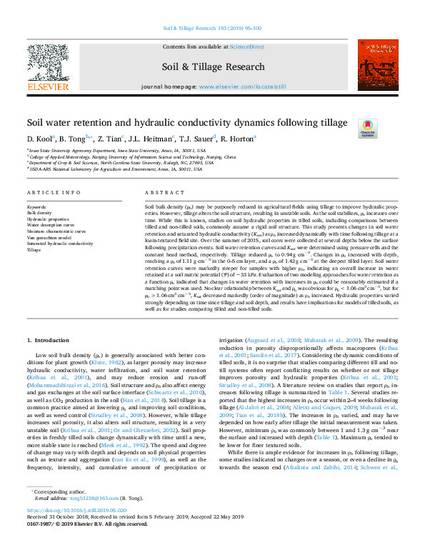
Soil bulk density (rhob) may be purposely reduced in agricultural fields using tillage to improve hydraulic properties. However, tillage alters the soil structure, resulting in unstable soils. As the soil stabilizes, rhob increases over time. While this is known, studies on soil hydraulic properties in tilled soils, including comparisons between tilled and non-tilled soils, commonly assume a rigid soil structure. This study presents changes in soil water retention and saturated hydraulic conductivity (Ksat) as rhob increased dynamically with time following tillage at a loam-textured field site. Over the summer of 2015, soil cores were collected at several depths below the surface following precipitation events. Soil water retention curves and Ksat were determined using pressure cells and the constant head method, respectively. Tillage reduced rhob to 0.94g cm−3. Changes in rhob increased with depth, reaching a rhob of 1.11g cm−3 in the 0–5cm layer, and a rhob of 1.42g cm−3 at the deepest tilled layer. Soil water retention curves were markedly steeper for samples with higher rhob, indicating an overall increase in water retained at a soil matric potential (Ψ) of −33kPa. Evaluation of two modeling approaches for water retention as a function rhobindicated that changes in water retention with increases in rhob could be reasonably estimated if a matching point was used. No clear relationship between Ksat and rhobwas obvious for rhob < 1.06cm3cm−3, but for rhob > 1.06cm3cm−3, Ksat decreased markedly (order of magnitude) as rhob increased. Hydraulic properties varied strongly depending on time since tillage and soil depth, and results have implications for models of tilled soils, as well as for studies comparing tilled and non-tilled soils.
Available at: http://works.bepress.com/robert-horton/128/

This article is published as Kool, D., B. Tong, Z. Tian, J. L. Heitman, T. J. Sauer, and R. Horton. "Soil water retention and hydraulic conductivity dynamics following tillage." Soil and Tillage Research 193 (2019): 95-100. doi: 10.1016/j.still.2019.05.020.